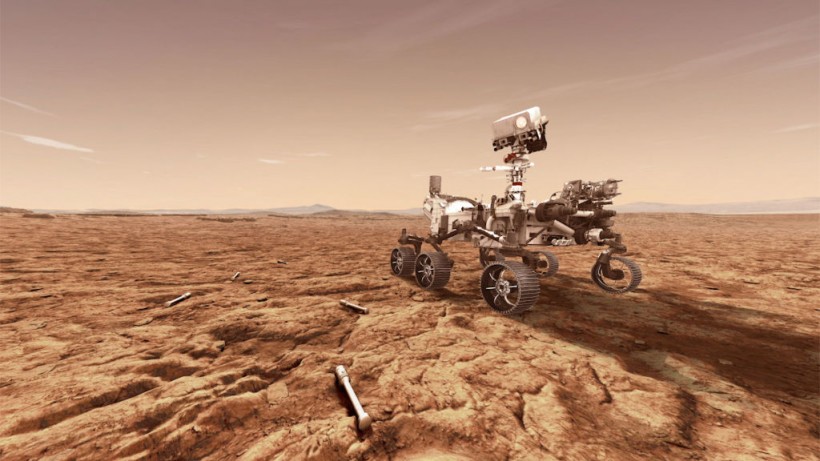The Perseverance rover recently collected another batch of rocks from planet Mars. According to the experts from NASA, the samples may hold a separate clue to the building blocks of life that once existed on that planet.
The rocks are not the typical stones we see every day, as most specimens found by Perseverance contain carbon, one of the essential components present in living things. The rocks were extracted from the Jezero Crater. The new collection was confirmed by NASA's Perseverance team last Wednesday, December 15.
Rock Samples from Jezero Crater Clue to Existence of Life on Mars

UNSPECIFIED: In this concept illustration provided by NASA, NASA's Perseverance (Mars 2020) rover will store rock and soil samples in sealed tubes on the planet's surface for future missions to retrieve in the area known as Jezero crater on the planet Mars. A key objective for Perseverance's mission on Mars is astrobiology, including the search for signs of ancient microbial life. The rover will characterize the planet's geology and past climate, paving the way for human exploration of the Red Planet, and be the first mission to collect and cache Martian rock and regolith.
Perseverance's harvest of the new rock samples does not translate that we have already found life on the red planet. Carbon is a substantial factor that could make up the existence of life. However, the chemical alone could not produce any biological form by itself. Alongside carbon, many contributing aspects are necessary to say that living things were present in the Martian environment.
After the collection process of Perseverance, the rock samples will be sent to Earth for examination. The study of the Martian specimens will be conducted through the collaborative efforts of experts from NASA and the European Space Agency. The time frame of the rock analysis is planned as early as 2031.
Scanning Habitable Environments with Raman and Luminescence for Organics and Chemicals (SHERLOC) lead and NASA's Jet Propulsion Laboratory expert Luther Beegle said in a report that some questions are revolving around the existence of life on Mars that would not be answered until the samples collected by Perseverance are delivered to Earth. According to the expert, the process of preserving the samples would provide an exciting deal for both the scientific community. Beegle explained that the rocks would provide significant information for many studies in the following years.
The first exploration of Perseverance around the Jezero Crater began last February. Since then, the rover has been trying to find the perfect Martian samples around the location that spans to 45-kilometer. The crater was theorized to house several water bodies in the past, including a river delta and several massive lakes.
Mission of Perseverance Rover on Mars
The rock collection is a part of a wider project of Perseverance in the red planet. According to a report by Space, the main interest of the rover was to provide Earth-based stations the first Martian samples, and of course, search for the remaining evidence of Martian life.
To complete the mission properly, Perseverance was equipped with 43 titanium tubes. Four of the specialized canisters were already opened to preserve the initial samples collected earlier this year. The Ingenuity helicopter landed on the surface of Mars and Perseverance. The first few weeks of the mission were dedicated to checking the rover's equipment before traveling across the red planet. SHERLOC technology was also able to relay data to the rover about the organics inside the rocks, following the initial findings harnessed by the great Curiosity rover.
Perseverance was also assisted by an instrument called the Planetary Instrument for X-ray Lithochemistry or PIXL to analyze a set of rocks gathered from Jezero's South Seitah region. According to the experts, these rocks are composed of high rates of olivine crystals and pyroxene crystals.
CalTech-Perseverance expert Ken Farley said that these textures could also be a comprehensive clue that magma once flowed from the crater, allowing the molten rocks to either form on a deep volcanic chamber or the creator floor's lava lake. Further studies will discuss the geological mapping of the planet through the help of the recent 10-meter radargram captured by the rover.
RELATED ARTICLE: How Is the Earth Formed? Deep Mantle Krypton Reveals the Answers
Check out more news and information on Space in Science Times.



![Earth's Quasi-Moon Kamo‘oalewa Could Originate From Lunar Surface Not Asteroid Belt [Study]](https://1721181113.rsc.cdn77.org/data/thumbs/full/53275/89/56/50/40/earths-quasi-moon-kamo-oalewa-could-originate-from-lunar-surface-not-asteroid-belt-study.png)










